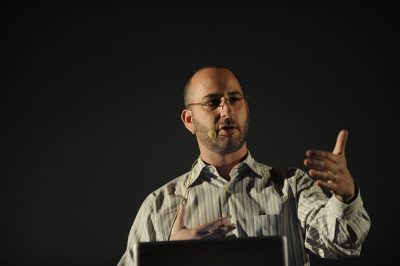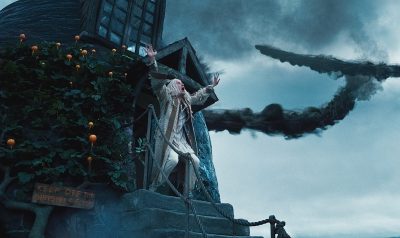We’ve had a fantastic time here at FMX in Stuttgart, which brought in around 3,500 attendees each day and 250 speakers. Day four was probably one of my favourites. It started with a two hour Harry Potter visual effects tribute looking at the work over all the past films. There were also great presentations today by Pixomondo, Pixar, Walt Disney Animation and Dreamworks Animation, and some insight on games development.
Below we take a brief look at the final day’s proceedings, and then talk to Proof’s Ron Frankel on his thoughts about stereo previs, something his company has produced for The Amazing Spider-Man.
The first Harry Potter film, The Philosopher’s Stone, arrived on our screens in 2001 and the final film in the series isn’t far away. During that ten year stretch, several visual effects houses contributed to the films. This session ran through each of the films, with individual showreels (with some break downs I’ve never seen anywhere else before) and presentations by Cinesite, MPC, Framestore, Dneg and ILM. It was amazing to see the growth in the scale and development of VFX in the HP films, especially from the London shops. MPC, for example, only had 26 or so employees for their first work on the films and of course now the studio has hundreds. Audience members also got to see an exclusive clip from Deathly Hallows Part II, in which Ron, Hermoine and Harry break out of Gringotts and fly over London.
Other presentations
There were some informative talks today by a number of major animation studios, including Pixar on Toy Story 3, Walt Disney Animation on Tangled, Illumination Entertainment on Despicable Me and Dreamworks Animation on Megamind. Saschka Unseld’s presentation on the cinematography and staging in Toy Story 3 and Cars 2 was particularly enlightening and he showed some great material on how scenes are blocked out and come together. Look out for an interview on fxguidetv with Saschka. Electronic Arts presented on Hot Pursuit and Fright Night Champion, while Microsoft Game Studios discussed Kinectimals. We were also able to watch Mohsen Mousav from Pixomondo discuss his studio’s sim work for Sucker Punch and Hindenberg, and you’ll see an interview with him on fxguide soon too.

Ron Frankel and stereo previs
Ron Frankel is the President and Founder of Proof, a company specializing in previs with recent credits on Fast Five, Water for Elephants and Hop. At FMX, Frankel presented a session on stereo previs, something Proof worked on for certain sequences in The Amazing Spider-Man. Although he wasn’t able to show any footage from that film, the audience saw some stereo previs created as a show-and-tell from Proof’s work on Fast Five, which was not a stereo film. We were able to talk to Ron about his thoughts on stereo previs after the presentation.
fxg: There seem to be two parts to your philosophy behind the need for stereo previs – both a technical side and a creative need – which I suppose feels like the idea behind normal previs.
Frankel: For me the proposition of any previs job is essentially how we can help move along help more along the creative force of the film – how we can help make story points and move the picture forward? That’s both for blocking the sequence but also for the lenses, speed and other things. As we move into more stereo films and stereo previs, I’m saying creatively this is a new dimension we need to understand as it functions as a narrative tool, but also looking at ways to understand what its practical implications are for day to day shooting.
The tools for creating stereo previs are right there and available. But the tools for analyzing stereo previs and understanding it don’t exist quite yet. One of the things I heard being talked about at FMX by a stereographer is that you cannot evaluate on set on a 40 inch screen how stereo is going to end up looking, and know that it will work on a 40 foot screen. We have exactly the same problem because we’re working on 24 inch screens.
fxg: So obviously more and more films are being shot in stereo or being converted – is stereo previs just really about making creative decisions as early as possible?
Frankel: I think it’s absolutely critical. I look at the success of animated features – they’re really doing a phenomenal job of crafting the stereo so that it plays out over the duration of the film, so you really begin to see emotional development and character development. Now, they live in a perfect world where they can actually go back and re-render things and they have the freedom to do that. On the live action side of it, we obviously can’t move to an animated pipeline, so I think previs can become the way before the film is made or shot to really think about and understand what filmmakers want to do with stereo. It has to work in conjunction with the art department, the DP, the stereographer, visual effects.
fxg: What tools are you currently using to do stereo previs? Have you had to adapt these from your traditional previs tools?
Frankel: When we started on The Amazing Spider-Man, they knew it would be a stereo film, so we knew from early on that we’d have to do stereo previs. We started developing the workflow tools, but actually 90 per cent of that work had already been Autodesk for Maya – that was work that they had done in collaboration with Dreamworks. They have the stereo cam tools built-in there and we added a bunch of scripting on top. One of the things we had to deal with was camera shake and we have a heads-up display on the camera so we added information about the convergence plane and interaxial details. We also tinkered the measurement which was in feet, and not terribly useful on set. Also the convergence plane was called the ZP – the zero plane – so we changed that as well.
On top of that we added a frustum tool that allows us to dial in a percentage of divergence. It helps us accommodate for screen size. You could say on a 40 foot screen, you don’t want your left and right eyes to diverge more than two per cent, because if they do you exceed that three inches eye distance and you won’t be able to discern the stereo. So we built upon in Maya where there is a way to see the convergence point, and we used some frustums that show the safe depth behind the zero plane and the safe depth in front of it, based on a percentage that the artists can dial in. So if we know it’s going to be for say TV, we know we can have a much bigger percentage of divergence.
fxg: What are the barriers to doing stereo previs – I’m assuming time and budget are obvious ones, but also don’t they want to leave some of those creative decisions until the film is being shot or has been edited?
Frankel: Cost is a barrier for sure. Although, cost is one thing and value is completely different. Cost is only a barrier if you’re not getting value for it. I think in terms of the visual side, currently the cost for stereo previs doesn’t yield enough because we can’t analyze it on set properly yet. We need to get more analytic tools because they’re going to help filmmakers more decisions about how to film things and set design. The other side is distribution and playback because it’s currently very difficult to set up a stereo viewing environment in pre-production. No one’s showing up to the screening room when there’s nothing to screen except the previs. It just doesn’t merit that. Maybe it will. I mean, it used to be they never brought an editor onto the set but now of course they do.
fxg: The barriers are also just where you can watch it and how many aren’t they – and that everyone needs to wear special glasses.
Frankel: Yes, I mean if the director’s not there you can’t really just email it to them. They can’t watch it on their iPad. Well, not yet. Someone showed me this pair of VR-type goggles which were like wraparound sunglasses with a headphone coming out of it which you can plug into your iPad and play a QuickTime. And if you do your QuickTime as a left/right pair it’s stereo. And it comes in a little sunglasses case. It’s not ideal because you can’t really have a bunch of people looking at it, but certainly it’s one way of watching it and I’m keeping my eye on that.
Thanks to FMX and Reiner Pfisterer for the FMX photographs in this post.

